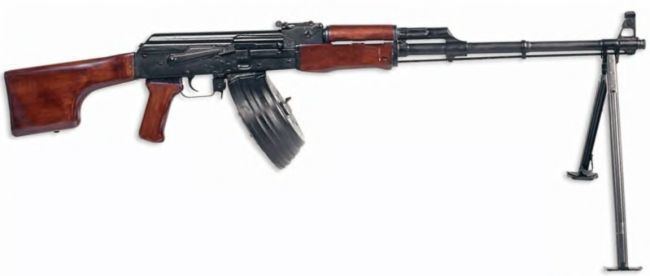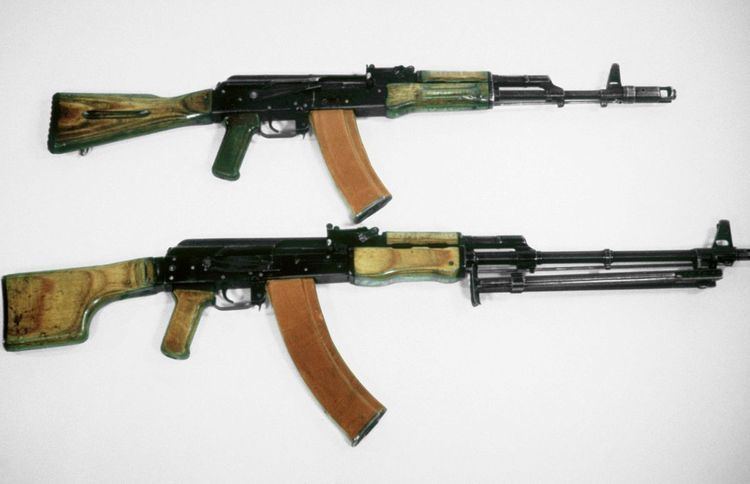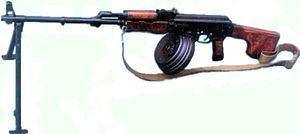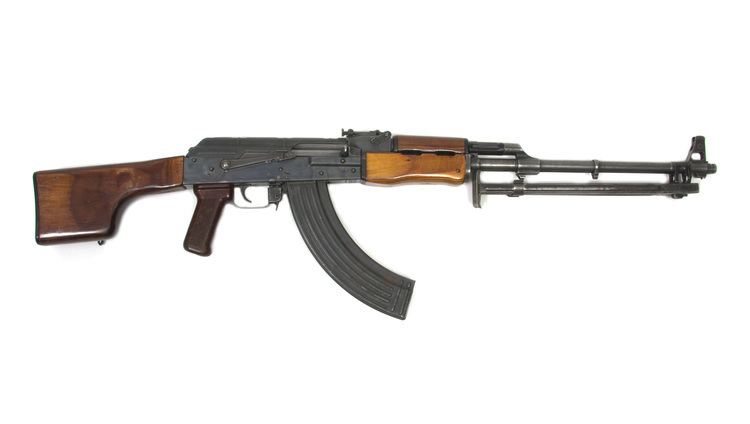Used by See Users | In service 1961–present | |
 | ||
Type Light machine gunSquad automatic weapon Wars Vietnam War*See other conflicts and wars | ||
The RPK (Ruchnoy Pulemyot Kalashnikova, Russian: Ручной пулемёт Калашникова or "Kalashnikov hand-held machine gun") is a 7.62×39mm light machine gun of Soviet design, developed by Mikhail Kalashnikov in the late 1950s, parallel with the AKM assault rifle. It was created as part of a program designed to standardize the small arms inventory of the Red Army, where it replaced the 7.62×39mm RPD light machine gun. The RPK continues to be used by the armed forces of countries of the former Soviet Union and certain African and Asian nations. The RPK was also manufactured in Bulgaria and Romania.
Contents
- Operating mechanism
- Features
- Sights
- Accessories
- RPKS
- RPK 74
- RPKS 74
- Night variants
- RPK 74M
- Molot Vepr
- Users
- References

Operating mechanism

The RPK functions identically to the AK-47. It also uses the same 7.62×39mm ammunition. It has a similar design layout to the AKM and AK-47 series of rifles, with modifications to increase the RPK's effective range and accuracy, enhance its sustained fire capability, and strengthen the receiver.
Features

Most notably, the RPK has a heavier and longer barrel than an AKM. This allows the RPK to fire for extended periods of time without major loss in accuracy due to the barrel heating up. The chrome-lined barrel is permanently fixed to the receiver, and cannot be replaced in the field. It is fitted with a new front sight base, gas block (lacks the bayonet lug) and an under-barrel cleaning rod guide. The barrel also features a folding bipod, mounted near the muzzle, and a front sight base with a lug that limits the bipod's rotation around the axis of barrel. The barrel's muzzle is threaded, enabling the use of muzzle devices such as flash hiders, compensators, and blank-firing adapters. When a muzzle device is not being used, the threads on the muzzle can be covered by a thread protector. The barrel is pinned to the receiver in a modified trunnion, reinforced by ribbing, and is slightly wider than the trunnion used on standard AKM type rifles. Symmetrical bulges on both sides of the front trunnion ensure proper fit inside the receiver.

The RPK also has a slightly longer receiver, by about 20mm or less. This was done to decrease the fire rate slightly, but it is not significant enough to lower it any less than 600 RPM.

The RPK's U-shaped receiver is stamped from a smooth 1.5 mm (0.06 in) sheet of steel (compared to the 1.0 mm (0.04 in) sheet metal receiver used on standard AKM rifles). Interchangeability of parts between the RPK and AKM is moderate.
The RPK uses a modified AKM recoil spring assembly. It consists of a rear spring guide rod from the AK, and a new forward flat guide rod and coil spring.
The RPK features a thick laminated wood foregrip, and a fixed laminated wood "club-foot" buttstock, similar to the stock used on the RPD, which is designed to allow the user to fire from the prone position more comfortably. The RPK uses a standard AKM pistol grip.
The weapon can use standard AKM detachable box magazines, but is most commonly used with a 40-round box magazine, or a 75-round drum magazine.
Sights
The weapon's rear sight leaf is elevation adjustable, and graduated for ranges of 100 to 1,000 meters, in 100 m increments. The rear sight leaf also features a windage adjustment knob, unique to the RPK series of rifles.
Accessories
Supplied with the RPK are: spare magazines, a cleaning rod, cleaning kit (stored in a hollowed compartment in the buttstock), a sling, oil bottle and magazine pouches (a single-pocket pouch for a drum magazine or a 4-pocket pouch for box magazines).
RPKS
An RPK with a side-folding wooden stock was intended primarily for the air assault infantry. The former Soviet Union issued the RPK mainly to motorised units. Changes to the design of the RPKS are limited only to the shoulder stock mounting, at the rear of the receiver. It uses a trunnion riveted to both receiver walls that has a socket and tang, allowing the stock to hinge on a pivot pin. The trunnion has a cut-out on the right side designed to engage the stock catch and lock it in place when folded. The wooden stock is mounted in a pivoting hull, which contains a catch that secures the buttstock in the extended position. The rear sling loop was moved from the left side of the stock body to the right side of the stock frame.
RPK-74
Introduced in 1974 together with the AK-74 assault rifle and chambered for the new 5.45×39mm high-velocity cartridge. The RPK-74 derives from the AK-74 rifle, with modifications that mirror those made to the AKM to create the RPK. The RPK-74 also uses a longer and heavier chrome-plated barrel, which has a new gas block with a gas channel at a 90° angle to the bore axis, and a ring for the cleaning rod. The RPK-74 was also equipped with a folding bipod and a different front sight tower. The muzzle is threaded for a flash suppressor or blank-firing device.
The rear stock trunnion was strengthened and the magazine well was reinforced with steel inserts.
Additionally, the RPK-74 has a modified return mechanism compared to the AK-74, which uses a new type of metal spring guide rod and recoil spring. The rear sight assembly, forward handguard and receiver dust cover were all retained from the RPK.
The RPK-74 feeds from a 45-round steel or polymer box magazine, interchangeable with magazines from the AK-74, and is designed to be charged from stripper clips. Drum magazines similar to those used on the previous RPK models were tested during the development phase of the RPK-74, but were discontinued in favor of the 45-round box magazine. However, recently the production of a 97 round drum has started. This drum was designed for use with the AK-107 but can be used in any 5.45x39mm gun with compatible magazines, such as the RPK-74 and RPK-74M. As well as experimental conventional drums, a prototype 100 round belt fed drum magazine was also created. It attaches into the regular magazine well, but the cartridges are stored on a 100 round belt inside a box. A fed system removes them from the belt and puts them in a position where they can be loaded through the regular magazine well. This system is actuated by a lever from the magazine that clips around the charging handle. It is unknown if this ever went into service.
Standard equipment includes: eight magazines, six stripper clips (15 rounds per clip), a speedloader guide, cleaning rod, cleaning kit, sling, oil bottle and two magazine pouches. Some variants do not come with the cleaning kit option.
It is in widespread use by member states of the former Soviet Union, as well as Bulgaria.
RPKS-74
The RPKS-74 is the paratrooper model of the RPK-74, equipped with a wooden folding stock from the RPKS.
Night variants
The RPK family of light machine guns is also available in a night fighting configuration. These weapons are designated RPKN, RPKSN, RPK-74N, and RPKS-74N. They have a side rail mounting on the left side of the receiver that accepts a NSP-3, NSPU, or NSPUM night vision sight. Models designated RPKN-1, RPKSN-1, RPK-74N and RPKS-74N can mount the multi-model night vision scope NSPU-3 (1PN51) while RPKN2, RPKSN2, RPK-74N2 and RPKS-74N2 can mount the multi-model night vision scope NSPUM (1PN58).
RPK-74M
An updated variant known as the RPK-74M (for Modefitsyrovannyj > "Improved") was developed. In line with the AK-74M assault rifle variant the RPK-74M lower hand guard, gas tube cover, pistol grip, and new synthetic stock are made from a black, glass-filled polyamide. The stock is shaped like the RPK-74 fixed stock, but also side-folds like the RPKS-74. Each AK-74M is fitted with a side-rail bracket for mounting optics. Updated magazines were produced by Molot with horizontal ribs going up the sides of the magazines. An export variant chambered in 5.56×45mm NATO was also introduced, designated the RPK-201. Also for export is the RPK M chambered in 7.62×39mm; it uses the same polymer furniture as the RPK-74M variant.
Molot Vepr
A series of semi-automatic rifles based on the heavy RPK receiver are manufactured by the Molot factory in Vyatskiye Polyany, Russia. These rifles are known as the Vepr and Vepr Shotgun (Vepr > "Wild Boar"). They are offered in several chamberings, including: .223 Remington, 7.62×39mm, 5.45×39mm, 6.5mm Grendel, 7.62×54mmR, .308 Winchester, .30-06 Springfield and 12 gauge, 20 gauge, and .410 gauge Vepr shotgun (ВПО-205 > VPO-205). The hallmark of Vepr rifles is their heavy RPK receiver and barrel. The barrel, gas block, and bore are chrome lined throughout. They are intended for the civilian market, and are marketed as high quality hunting rifles. Due to this designation, they lack features seen on most AK type rifles. Vepr rifles do not include a bayonet lug, integrated cleaning rods or tool kits, can not accept standard AK magazines, and have wooden thumb-hole stocks. Some buy these rifles to "convert" into a traditional style AK rifle, installing new pistol-grip stocks and adding tactical accessories.
Early generations of the Vepr rifle were manufactured with slant-back receivers, making them incompatible with most AK furniture sets without a converter. The receivers were changed to straight-back in the second generation. Subsequent versions of the rifle reverted to slant-back. Due to this rapid change between designs, it is not uncommon to find some second generation Vepr rifles with rough, incomplete stocks that have not been sanded or painted.
Users
RPK-74: Limited usage by airborne forces, last known RPK-74s were withdrawn from service in 2005 with Tantals.
